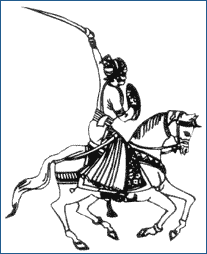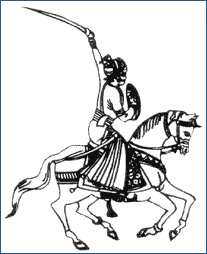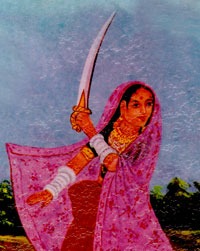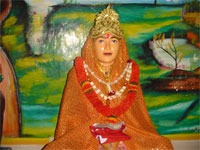Vansh : Agnivanshi)
Chauhan with 26 branches. (Major Shakhas – Hada or Hara, Songara, Deora, Khichi, Shambhri, Sanchora, Pavia, Goyalwal, Bhadauria, Malani, Nirwan, Puravia,Madrecha, Cheeba, Mohil, Chahil, Balecha, Chachera, Boda, Nadola, Nikumbh… etc.
In Maharashtra the septs are: Chavan, Tawade, Gavane, Hande, Pansare, Randive, Kalbhor, Ispute, Kedar.
According to the Rajput bards the Chauhan is one of the four (and the last) Agnikula or ‘fire sprung’ tribes who were created by the gods in the anali kund or ‘fountain of fire’ on Mount Abu to fight against the Asuras or demons. According to legend:” Again Vashista (or Agastya) seated in the lotus prepared incantations; again he called the gods to aid, and as he poured forth the libation a figure arose; lofty in stature, of elevated front, hair like jet, eyes rolling, breast expanded, fierce, terrific, clad in armour with quiver filled, a bow in one hand and a brand in the other, quadriform (chaturanga) , hence the name was given as Chauhan”. Another explanation is: that the Chauhan was born from the fourhanded warrior Chatur-bhuja, Chatur-baha or Chaturvira.
This account makes the Chauhan the most important of the fire clans, and colonel Tod says that he was the most valiant of the Agnikulas, and it may be asserted not of then only but of the whole Rajput race though the swords of the Rathors would be ready to contest the point. Chauhan is also one of the 36 (royal) ruling races of the Rajputs. The Chauhans come from Jaipur and its environ Sambhar (as found from inscriptions) and Ajmer (which is said to been founded by them in the 11th century) in Rajputana appear to have been the first home of the clan, and inscriptions record a long line of 39 kings as reigning from Anhul, the first created Chauhan. The last of them, Vigraha Raja or Bisla Deo, in the middle of the 12th century extended the ancestral dominions considerably, and conquered Delhi from a chief of the Tomara clan. At the time the Chauhans, according to their own bard , held the line of the Nerbudda from Garha Mandla to Maheswar and also Asirgarh, while their dominions extended north to Hissar and south to the Aravalli hills.
The nephew of Bisal Deo was Prithvi Raj Chauhan, the last Hindu Ruler of Delhi. He ruled at Sambhar, Ajmer and Delhi. His first exploit was the abduction of the daughter of Jaichand, the Gaharwar (or Rathore) Raja of Kannauj in 1175. The king of Kanauj had claimed the title of universal sovereign and determined to celebrate the Ashwa-Medha or horse sacrifice, at which all the offices should be performed by vassal kings. This was the last Asvamedha performed by a Hindu king. Pritvi Raj of Delhi and Samarsi of Mewar alone declined to attend as subordinate, and Jaichand therefore made a wooden image of him and set it up at the gate in the part of the doorkeeper. But when his daughter after the tournament took the garland of flowers to bestow it on the chief whom she chose for her husband, she passed by all the assembled nobles and threw the garland on the neck of the wooden image. At this moment Prithvi Raj dashed in with a few companions, and catching her up, escaped with her from her father’s court. Mer. E. Balfour: ” In this successfull rape he lost the flower of his followers and his subsequent defeat by the Muhamaddans has been partly attributed to this. Jaichand , though bereaved of his daughter sent her jahez or trousseau after her. Jaichand closed his career by lapsing into the Ganga at Ferozabad, the ancient Chandwar.”
Afterwards, in 1182, Prithviraj defeated the Chandel king Raja Parmal and captured Mahoba. In 1191 he was the head of a confederacy of Hindu kings in combatting the invasion of Huhammad Ghori. He repelled the Muhamaddans at Tarain about 2 miles north of Delhi, but in the following year was completely defeated and killed at Thaneswar, and soon afterwards Delhi and Ajmer fell to the Mohammedan. The Chauhan kingdom was broken up, but scattered parts of it remained, and about 1307 Asirgarh in Nimar, which continued to be held by the Chauhans, was taken by Ala-ud-din Khilji and the whole garrison put to the sword except one boy. This boy, Raisi Chauhan, escaped to Rajputana, and according to the bardic chronicle his descendants formed the Hara branch of the Chauhans and conquered from the Minas the tract known as Haravati, from which they perhaps took their name. This is now comprised in the Kotah and Bundi states which is now ruled by Hara chiefs. Another well-known offshoot from the Chauhans are the Khichi clan, who belong to the Sind-Sagar Doab; and the Nikumbh and Bhadauria clans are also derived from them. The Chauhans are numerous in Punjab and UP and rank as one of the highest Rajput clans. In the Central Povinces they are found mainly in the Narsinghpur and Hoshangabad Districts, and also in Mandla. The Chauhans of the Karnal district being closer to Delhi and the Muslim kings started converting to Islam from the 14th to the 17th Century. Chauhans in Rajastan are few in number and live in Alwar district of Rajastan.
Article supplied by Kishan V Sisodia










